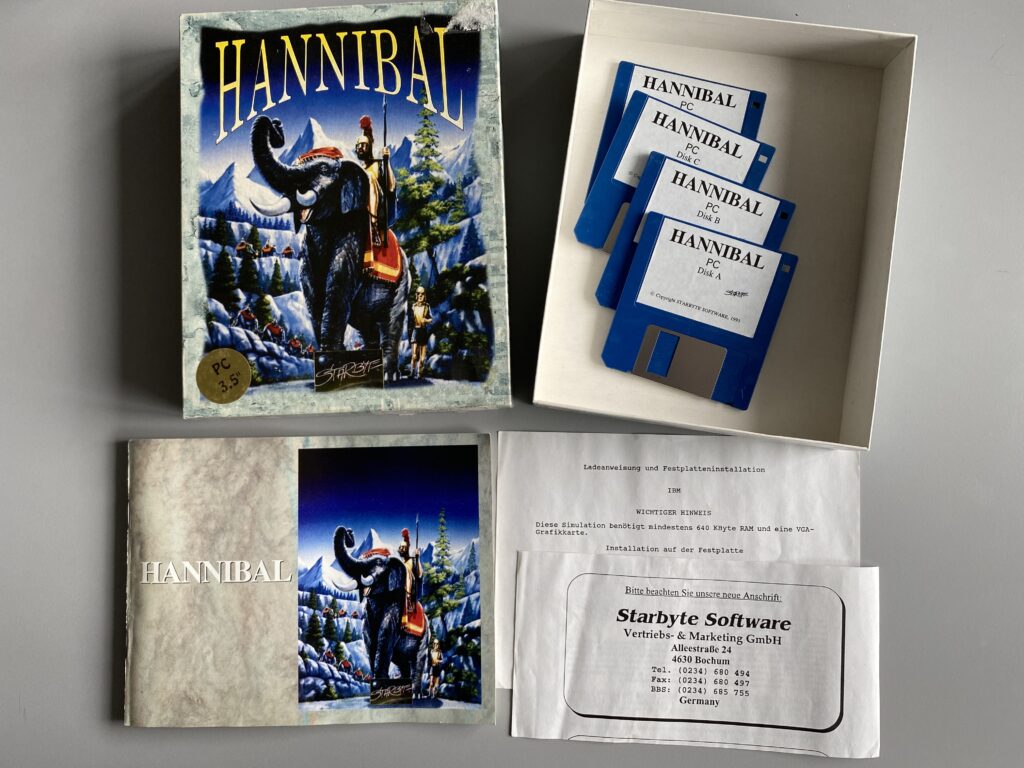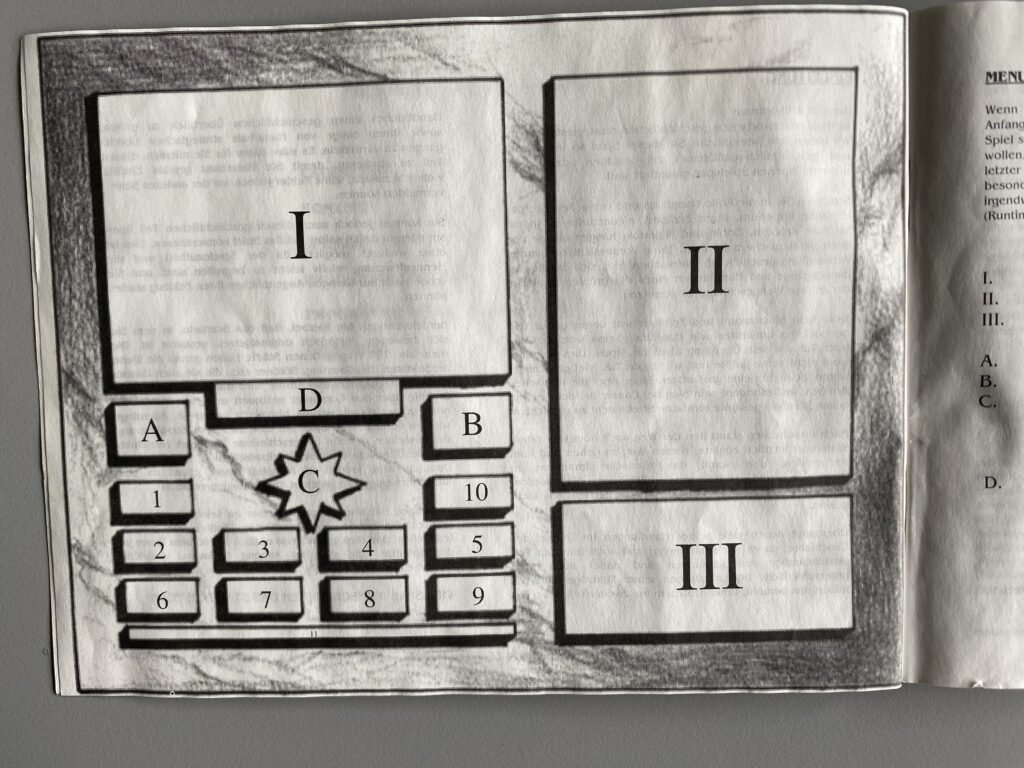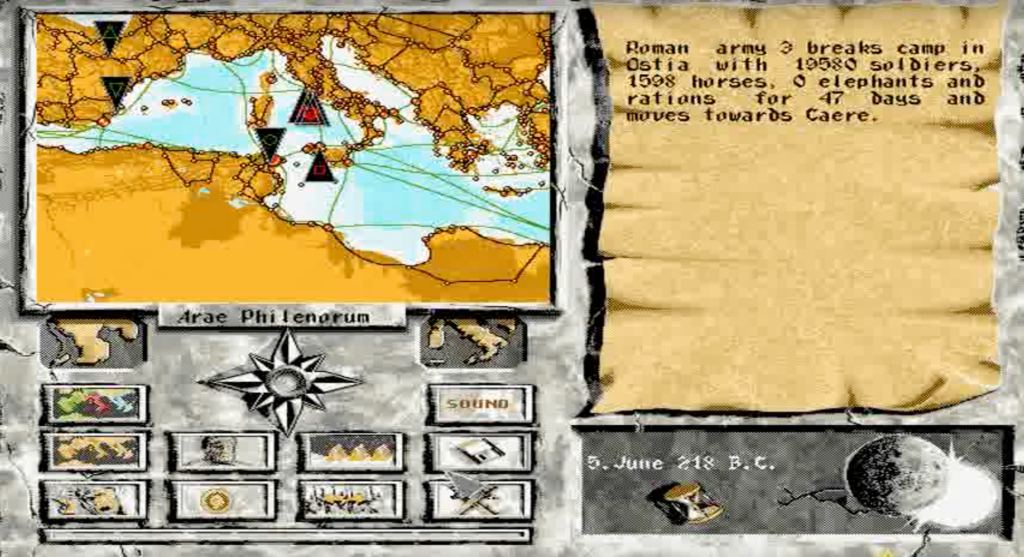Instruction Manuals – accessible and for everyone, but now obsolete
Most games in the 80s and 90s came on discs or CD-ROMs in artful cardboard boxes and contained an insightful instruction manual. The printed booklet was essential for teaching how to play the game, telling a story or prologue and making a player familiar with the computer system the game was made for. Instruction manuals were clear and detailed, often even extensive. The Swiss games of the 80s and 90s relied on them as much as any other game. These instruction manuals showed an interesting diversity of approaches from story booklets over cartoons to extensive strategy guides.
Part 1 — A Serious Manual
“It is about Hannibal, but you already knew that … didn’t you?”
This is how a quick intro for the game Hannibal of 1993 starts, most likely written for people who did not buy the game through official channels. There was a prolific piracy (or warez) scene in those days: Not everyone could afford to buy the games from the stores. So, a lot of people didn’t use the boxed originals but copied them. This was possible because most of the games came on floppy disk(s).
The intro continues in a jovial manner resuming and shortening the storyline:
“Hannibal has a little argument with the Romans and cause he gets angry very fast, he just decides to wipe out he entire Roman Race. Naturally this didn’t work, so now you get this change (chance).” (Lemonamiga, with original mistakes)
The quick doc is written by a gamer called acid queen. What they mean seems to compare more to a behavioral description of a gamer than a reference to history: Hannibal gets angry very fast and decides to wipe out everybody. Since this did not work in history, you get the chance now in the game.
The next two lines refer to the booklet that accompanies the game when bought from an official dealer in a game box (presumably for DM 99 or CHF 80):
“If you want the FULL story-Line, just by (sic!) the Manual of the Game, or go to a Library ( A place where they Keep Books they Say ).” (Lemonamiga)
The early game developers of the 80s in Switzerland often started as Crackers. They cracked legal games, altered their intros, and distributed copies with their extra animations and messages among friends and within the warez community. In general, a manual or a quick intro was not included. But some pirated games were sold by warez groups and had some quick info for the game on a flyer that was folded over the duplicate floppy disk and stuck in a small plastic envelope. Without this quick instruction it was sometimes difficult for the player to find out how to operate the game.
The official games came as cardboard boxes that were printed on the outside and contained a booklet as well as the disc(s) (Figure 1). Packaging designers used the large surface area of the box to draw additional attention to the game with their artwork. The cover usually featured a color printed concept art, and the back often contained a short promotional write-up of the game and some screenshots or drawings. Content creators took the opportunity to fill the game boxes with various things like goodies, fictive texts, posters, and stickers.

Figure 1: Hannibal (1993) came like most games of that time in a cardboard box with artwork, floppy disks, a couple flyers with additional information and an insightful booklet as instruction manual. Source: Photo Suter.
The Thorough Booklet
The Hannibal booklet comes in the official game box with floppy discs and features a completely different standard of information and writing than the quoted ‘quick intro’. The booklet has 48 pages with two columns per page and a colorful illustrative picture of Hannibal’s elephants traversing the snowy alpine mountains (Figure 2).

Figure 2: Booklet for Hannibal (1993). Source: Photo Suter.
It starts with a polite and friendly welcome that assures you the developers took a serious approach to create a strategy simulation that is based on thoroughly researched historical context for Hannibal’s campaign to invade the Roman empire.
“Herzlich Willkommen
Zu Ihrer neuerworbenen geschichtlichen Strategiesimulation. Wir haben uns bemüht, für Sie dieses Spiel so interessant und geschichtlich realitätsnah zu gestalten, daß Ihnen mehrere Wochen Spielspass garantiert sind.” (Hannibal 1993 Einleitung)
“Welcome
To your newly acquired historical strategy simulation. We have tried to make this game so interesting and historically realistic for you that you are guaranteed several weeks of fun.“ (Translated by author)
After an initial general introduction by the Starbyte team, the next pages come with a simplified box graphic and explanation of the UI (User Interface) (Figure 3), showing that the game works with maps, a large text window for events and action news on parchment paper.

Figure 3: User Interface outline as shown in the manual. Source: Photo Suter.
Mouse control and GUI were rather new at the time, they needed to be explained in detail. Beneath the map window, you find a wind rose, two buttons for switching maps and 10 other functional buttons, all of them appropriately illustrated. Beneath the parchment news window, you find a time indication button that tells you when the playing events take place – e.g., 1. June 218 B.C. All of this is shown in a in-game screenshot of the described UI (Figure 4).

Figure 4: User Interface as seen in the game with map display (top right) and event news (top left). Source: screenshot Suter.
Starbyte has taken great pains to approach this booklet as seriously as possible. The target audience was probably not only the well-known young gamers, but everyone interested in history and historical events or in rather thorough strategy games. The next four pages are filled with detailed descriptions of what happens when you use the nice menu points 1 – 9 on the lower left. Menu point 4 for example let you send your armies into a winter camp if you use the button after 1. November and forwards the time to 1. April next year, showing you also in the news window, what was the outcome of all negotiations that took place during the winter period.
Context
And here, after 12 pages, the actual instructions for the game already come to an end. On the next page, the explanations of the historical references begin. First, four pages are devoted to the city of Carthage and its development.
This is followed by a description of the Punic Wars on four pages again. Finally, the showpiece is a ten-page biography of Hannibal with a photography of his bust (in stone). The warlike events in Hannibal’s life – as well as before and after – are described almost without any gaps, so that the reader gets an excellent guide for his game. Unfortunately, the whole booklet remains without references.
Explanations of historical battle tactics follow on the next 8 pages. The individual battle formations are depicted by means of diagrams (Figure 5) and the individual different fighters with characteristic drawings. Two additional photographs also embed this explanation in an authentic historical context. The historical references are rounded off with a two-page chronology of the events from 247 to 183 B.C.

Figure 5: Battle formations as sketched in the manual. Source: Photo Suter.
And finally, before the copyright page, there are two pages of tips and tricks, which are intended as helpful gameplay advice and should make the players‘ gameplay a little easier if they want to accept these tips. Tip 6, for example, advises: “Plündern sie Städte nur, wenn sich ihre Armeekasse dem Ende zuneigt, und die Imperiumskasse nicht genügend enthält.”(Hannibal 1993, p.44), “Only pillage cities when your army treasury is low, and the empire treasury is running out soon.” (Translated by author) And tip 10 says dryly: “Es ist nicht ratsam, Rom mit weniger als 200’000 Soldaten anzugreifen.” (Hannibal 1993, p.45). “It is not advisable to attack Rome with less than 200,000 soldiers.” (Translated by author)
In the end of the booklet, you find three empty pages to take notes – a common sight in game manuals of the 80s and 90s. Mostly, they needed to add some more pages to have an odd number for the printing process. But some games came with code that you could write down on those pages or you were able to make a note about an in-game secret, an easter egg or remember an unforeseeable choice or a cheat code. But gamers that loved those manuals would never write down anything on those pages, they rather memorize cheats or write them down on a separate paper.
Cost saving
The paper itself was often thin or otherwise cheap. The printing was not supposed to be too expensive. So, publishers saved cost on paper quality (Figures 4 and 5) and with a smaller size of the printed text. The Hannibal booklet used thin paper and put two text pages on one in a small font size (possibly 8) in two columns. Only the cover was better quality and featured a surprisingly colorful illustration (Figure 2).
See also:
Part 2 — The Story Booklets — (Link)
Part 3 — From Strategy Guides to Downsizing — (Link)
Beat Suter (CH-Ludens, 20. September 2023)
